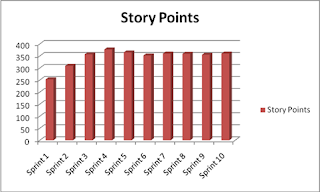Sprint Velocity = Total story points “completed” in an iteration
For example: if the team took on 360 story point in the sprint but only finished 352 story points. Their velocity for that sprint/iteration would be 352 story points
Sprint Average Velocity = Total story points “completed” to date / number of iteration completed
For Example: You Sum up the values for the 10 sprints below to get a value of 3447.
You then divide it by the number of iterations, 10 in our case to get an average velocity of 344.7 story points
You then divide it by the number of iterations, 10 in our case to get an average velocity of 344.7 story points
Sprint | Story Points |
Sprint 1 | 253 |
Sprint 2 | 309 |
Sprint 3 | 357 |
Sprint 4 | 377 |
Sprint 5 | 365 |
Sprint 6 | 352 |
Sprint 7 | 360 |
Sprint 8 | 359 |
Sprint 9 | 355 |
Sprint 10 | 360 |
Total SP 3447 |
3447 Total Story Points / 10 Sprints = 344.7 is our average Sprint/Iteration velocity
NOTE: Your velocity usually normalizes after 3 to 5 sprints allowing you to use this number to project how much can be done in the next iteration and ideally how much longer a release will take to complete considering the number of estimated stories remaining in the backlog.
Example Velocity Chart

No comments:
Post a Comment